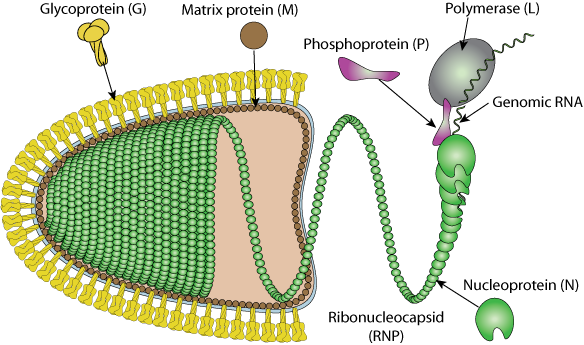VIRION

Enveloped, bullet shaped. 180 nm long and 75 nm wide.
GENOME
Negative-stranded RNA linear genome, about 11 kb in size. Encodes for 5 proteins, plus 4 by alternative initiation.
GENE EXPRESSION
The viral RNA dependent RNA polymerase binds the encapsidated genome at the leader region, then sequentially transcribes each genes by recognizing start and stop signals flanking viral genes. mRNAs are capped and polyadenylated by the L protein during synthesis.
ENZYMES
- RNA-dependent RNA polymerase [L]
- Mononega-type capping
- RNA TPase, GTase, N7 Mtase, 2'O Mtase [L]
REPLICATION
CYTOPLASMIC
- Attachment of the viral G glycoproteins to host receptors mediates Clathrin-mediated endocytosis of the virus into the host cell.
- Fusion of virus membrane with the vesicle membrane; ribonucleocapsid is released into the cytoplasm.
- Sequential transcription, viral mRNAs are capped and polyadenylated by polymerase stuttering in the cytoplasm.
- Replication presumably starts when enough nucleoprotein is present to encapsidate neo-synthetized antigenomes and genomes.
- The ribonucleocapsid binds to the matrix protein and buds via the host ESCRT complexes occurs at the plasma membrane, releasing new virions.


